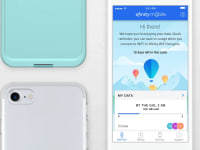You’ll be giving up things like access to your banking app of choice to pay bills, no way to check in with your friends outside of a text or call, and no way to stream all the tunes you’ve saved on Spotify or Apple Music, but that’s that point. At $300, though, it’s not much cheaper than many budget phones that can do a lot more, so you have to be really committed to the Light Phone’s philosophy of using your phone as little as possible.
A simpler phone
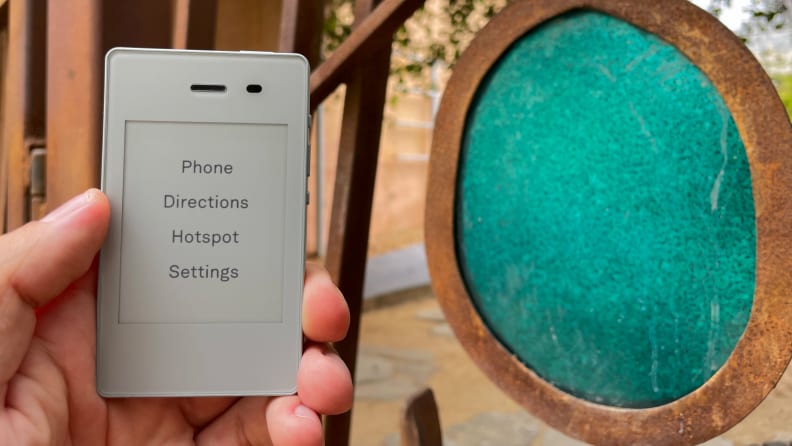
The Light Phone 2 is slightly taller than a pack of cards and looks like a mix between an iPhone and a Kindle Paperwhite. On top of the device, there’s a power button and a headphone jack (the Light Phone does support music playback, but you can’t stream anything), and on the right-hand side there’s a volume toggle and a menu button for navigating the device’s OS.
The volume toggles were a bit weird because rather than the up and down buttons being right next to each other, they’re separated by the menu button. This can feel weird at first, and before getting acquainted I found myself hitting the menu button when I meant to turn the volume down on a call.
The display, which is just under three inches diagonally, is significantly smaller than the screen you’d find on any modern smartphone, but it also doesn’t have to show nearly as much information. Like Amazon’s Kindle e-readers, the Light Phone uses an e-ink display that looks more like ink on paper than dots on a grid of lights.
Unlike the more refined screens on Amazon’s readers, though, the Light Phone’s display suffers from occasional ghosting (artifacts or tiny pieces from previous pages) and a lot of light bleed. In rooms without a ton of light, it’s easy to see the backlight of the phone bleeding through the top and bottom of the display, and while it isn’t terrible, it’s not what you’d expect from a $300 device.
The phone is small enough to hold in one hand, but that smaller size comes with a major drawback: It’s not great for making calls. Because the device is short at just under four inches tall, you can’t easily sandwich it between your ear and shoulder like you could a larger smartphone.
That also means that the microphone isn’t as close to your mouth as it would be with other devices. In practice, call quality is mostly fine, even with a spotty connection. In my testing, the person on the other end was able to hear me just fine with a single bar of service, but I had trouble hearing them a few times throughout a long call.
Back to basics
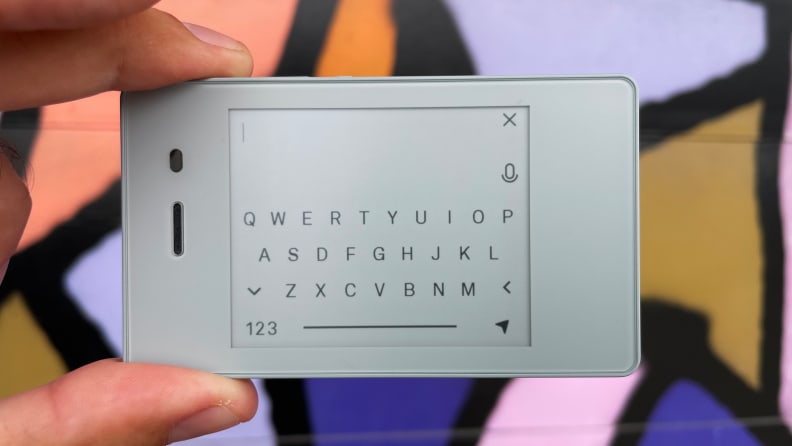
When you turn on the Light Phone, which takes a little over a minute to fully boot up, you’re greeted with a barebones interface that lets you navigate between the Phone app, Alarm app, and Settings. If you’ve synced any podcasts or songs to your device (which you can only do through the company’s web portal), those will show up, too.
There are also apps for navigation and a hotspot feature, though they have to be enabled through Light’s web dashboard, so you won’t be able to use these features right out of the box. Setting it all up was easy enough, but there’s an extra step involved that makes it less streamlined than any other modern device.
If you do enable the hotspot feature, the good news is that it works surprisingly well. Connecting is as easy as toggling the feature on, going into your Wi-Fi settings on another device, and connecting as you would to any other network. Speeds will vary depending on your carrier’s plan and coverage, but on Simple Mobile (which connects to T-Mobile towers) in an area with decent coverage, my iPhone didn’t have any issue connecting to the Light Phone’s hotspot.
Navigating the Light Phone’s interface is a breeze, too. Pressing the menu button on the side will take you to a menu of all your installed apps so you can easily switch between them. The Phone app allows you to place calls from a Dialpad, add new contacts to your address book, search your contacts, or compose a new text message.
Composing those messages is tricky, though: The e-ink display isn’t particularly responsive, so there’s some lag between when you touch the screen and when it registers in the system, so if you’re a fast typer you may end up with more typos than you’re used to.
Fortunately, for those who find the typing experience on the Light Phone to be a pain, there’s a voice-to-text feature that works well enough. In my testing, it picked up everything I said without much issue, but there were some funky little hiccups that you wouldn’t find on an iOS or Android device.
For instance, saying “Hey there, how’s it going question mark” on an iPhone would produce the following text: “Hey there, how’s it going?” On the other hand, doing so on the Light Phone produced a message that said “Hey there. How’s it going question mark?”
Painful setup

Depending on your carrier, setting up the Light Phone 2 as a secondary device when you want to unplug from your smartphone’s flurry of notifications can be a painful endeavor. Despite Verizon’s website claiming that the Light Phone is supported, several Redditors have noted issues with the Verizon’s number share service. To Light’s credit, they’ve said they’ve asked Verizon to update their website with the accurate information about compatibility with the Light Phone, but that hasn’t seemed to happen yet.
Since I couldn’t tie my Light Phone to my existing phone number, I opted for a prepaid plan from Simple Mobile. It worked perfectly fine, and I never had any issues connecting to the network, but the lack of compatibility with my primary carrier’s service defeated the purpose of having a secondary device that could still hold all my messages and calls. Instead, I ended up with two phones with two separate numbers, trying to convince my friends to text the Light Phone number rather than my iPhone, sometimes to no avail.
However, Light does sell its own phone plans that run on AT&T’s towers: $30 a month for unlimited calls and messages with 1GB of data, and $70 a month for unlimited calls and messages, and data for hotspot usage. You can transfer your phone number to its service, too (I was unable to test that feature), so if you don’t have AT&T and don’t mind leaving your network, you’ll have a much easier time getting the Light Phone 2 set up.
How it felt to actually unplug
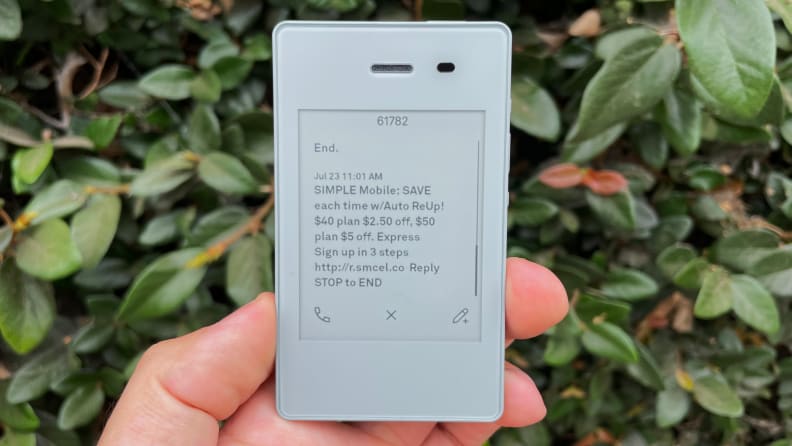
Within the first few days of carrying the Light Phone around, I felt refreshed. The pull to check my social media feeds or find something interesting to read to stave off boredom became less frequent, and I only texted friends when I really felt like talking or meeting up. It felt nice not being beholden to an endless stream of notifications.
After a few days, though, the cracks started to show. I couldn’t quickly Google the answer to a question scratching at the back of my brain, scan a QR code to view a restaurant’s menu, or even do a quick search to find a spot to eat. I wasn’t just escaping the worst parts of carrying a computer in your pocket, I was missing out on all the conveniences that the same device offers on a nearly hourly basis.
You can alleviate some of this by keeping your smartphone nearby and only using it over the Light Phone’s hotspot when you need to check something quickly, but then that sort of defeats the purpose of unplugging—you’re just giving yourself more steps to getting what you need.
If you use the Light Phone as your daily driver, you’ll find yourself sighing in the face of inconvenience as frequently as you used to check your Instagram. On the other hand, using it in conjunction with a smartphone defeats the purpose of truly unplugging, and it just takes up more space in your pocket or bag.
The final verdict
There’s a lot to love about what the Light Phone 2 offers: It’s a compact, simple phone that won’t bombard you with constant notifications. It excels at that, but it also becomes immediately clear how difficult it is committing to that concept. Things like spotty navigation, a laggy screen that makes texting difficult (plus subpar voice-to-text), and a lack of useful third-party apps leave you with just the basics, and few options for expanding without carrying another device with you.
If you’re dead set on tuning the digital world out, the Light Phone 2 offers a way to do that without completely disconnecting, but you may find yourself missing little things like having a camera or being able to do a quick Google search to see what Tom Cruise movie was shown in The Lego Batman Movie. For $300, you’re giving up more than what the Light Phone 2 gives back in return.
The product experts at Reviewed have all your shopping needs covered. Follow Reviewed on Facebook, Twitter, Instagram, TikTok, or Flipboard for the latest deals, product reviews, and more.
Prices were accurate at the time this article was published but may change over time.
电子纸行业网版权所有,转载请注明出处:https://www.e-paper.org.cn/?p=5153

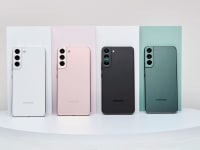
 FEATURE
FEATURE